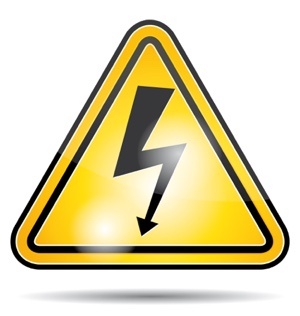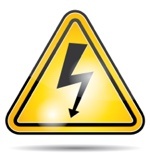 A few weeks ago we introduced you to the Occupational Safety and Health Administration’s (OSHA) Fatal Four – four safety hazards that account for the majority of all construction worker deaths (click here for our post).
A few weeks ago we introduced you to the Occupational Safety and Health Administration’s (OSHA) Fatal Four – four safety hazards that account for the majority of all construction worker deaths (click here for our post).
Understanding how to recognize and prevent these hazards can save lives, improve employee morale, and help reduce contractor insurance costs.
The Fatal Four include the following hazards (statistics are from 2016).
- Falls accounted for 38.7% of deaths
- Being struck by an object accounted for 9.4%
- Electrocutions accounted for 8.3%
- Caught-in/between accounted for 7.3%
We covered caught-in/between hazards in our prior post, and will now turn our attention to electrocution hazards.
Electrocution – Death by Electrical Shock
Exposure to lethal amounts of electrical energy causes electrocution, which is death by electric shock. The human body acts as a conductor when it comes in contact with an electrical current and electricity flows through conductors to create complete a circuit.
Exposure to as little as 50-100 mill amperes of current can cause death by electrocution. Most 120 Volt circuits carry 15-20 amperes of current, which is 300 times what is needed to kill someone by electrocution.
Electrical hazards can cause electric shock, electrocution, burns, arc flash or blast, fires, and explosions, which can lead to severe injuries or death. Common causes for electric-related injuries include getting too close to overhead and underground power wires, damaged equipment, faulty wiring, improper cord use, lack of GCFIs, and wet or cramped conditions.
According to the Electronic Library of Construction Occupational Safety & Health, the major causes of electrocutions in electrical workers and other construction workers in the U.S. between 1992 and 2003 included the following:
- Electrical wiring and equipment (accounted for the majority of deaths among electrical workers)
- Overhead power lines (accounted for the majority of the deaths among non-electrical construction workers)
- Machinery, appliances
Unaware of the Risks
Many construction workers are not aware of potential electrical hazards, which makes them more vulnerable, and it is your responsibility to make your employees aware. OSHAstates, "The employer shall instruct each employee in the recognition and avoidance of unsafe conditions and the regulations applicable to his work environment to control or eliminate any hazards or other exposure to illness or injury."
According to OSHA, these the most frequently cited electrical standards involving electrical hazards in construction:
- General requirements for electrical conductors and equipment
- Wiring design and protection
- Wiring methods, components, and equipment for general use
- General requirements for protection of employees
Electrical Safety Measures That Can Lead to Lower Contractor Insurance Costs
1 - Overhead Power Lines
Both overhead and underground power lines carry a high voltage. Injuries with power lines are often caused by contact with heavy equipment, ladders, lifts, etc.
The best way to avoid this hazard is to be aware of the location of power lines and maintain a safe distance. OSHA’s minimum clearance distance from overhead power lines is 2 feet for less than 300 volts, 10 feet for 300-50,000 volts, and 10 feet plus 4 inches for every 10,000 volts over 5,000 volts. This area should be cordoned off. If you have no choice but to work around power lines, contact the utility company to have the lines de-energized.
Other precautions include using nonconductive tools and equipment and avoiding the storage material directly underneath power lines.
2 - Ground-Fault Protection
According to OSHA, all 120-volt single-phase, 15- and 20-ampere receptacle outlets that are not part of the permanent wiring of the structure that employees use must have ground-fault circuit interrupters (GFCIs). A GFCI is a fast-acting circuit breaker that shuts of electricity when it senses small imbalances in the circuit. GFCIs only protect against the ground fault, but that is the most common form of electric shock hazard. It also protects against fires, overheating, and destruction of insulation on wiring.
3 - Lockout/Tagout Procedures
This procedure requires that a designated individual be assigned to make sure that all machinery and equipment are turned off and disconnected before performing service or maintenance. That individual will also lock or tag the energy-isolating device(s) to prevent the release of hazardous energy and take steps to verify that the energy has been isolated effectively.
Following this procedure helps safeguard employees from the unexpected energization of hazardous energy during service or maintenance. A qualified person should also be on hand when the locks and tags are removed, and the equipment is re-energized.
4 - Maintain Cords
There are a lot of portable tools that make life much easier at a construction site, and most of these tools come with flexible cords. These cords can be damaged by staples, rubbing against other objects, or by age. If the electrical conductors become exposed, those cords can become a hazard causing shocks, burns, or even fire. It’s important to regularly inspect all equipment and extension cords for cuts, frays, or exposed bare wires.
5 – Other Safety Measures
Other safety measures to reduce injuries associated with electrical work include the use of insulation, guarding, electrical protective devices, and compliance with OSHA’s regulations on electrical safety. OSHAoffers many resources to help ensure the safety of your workers.
The safer your employees, the lower your insurance costs. It’s a win-win!
Don't Miss This Easy Way to Save on Contractor / Construction Insurance!
 A great way to lower your contractor insurance costs is to simply contact American Insuring Group at (800) 947-1270 or (610) 775-3848 or connect with us online.
A great way to lower your contractor insurance costs is to simply contact American Insuring Group at (800) 947-1270 or (610) 775-3848 or connect with us online.
Our independent agents will compare the cost of your construction insurance options among several reliable insurance companies to make sure that you’re getting the right coverage at the best price!
Call today to get started.







